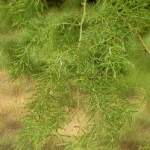| Common Name: |
Shatavari |
| Botanical Name: |
Asparagus racemosus |
| Genus: |
Asparagus |
| Family: |
Asparagaceae |
| Native Location: |
S and E Africa to Asia and N Australia. |
| Cultivation: |
Rich, light, well-drained soil, in a sunny position. Asparagus officinalis is often purchased as a dormant one-year-old male "crown" and renewed after 10 years. Asparagus racemosus may be grown as an annual in cold areas; protect under cover in winter. Asparagus beetle may attack young shoots and foliage. |
| Propagation: |
By seed sown in spring, sown at 16°C (62°F), thinned to 30cm (12in) apart, then to 1m (3ft) apart; by division in early spring. |
| Harvest: |
Young "spears" (shoots) of A. officinalis are cut in late spring from established plants when about 23cm (9in) high, then eaten fresh or juiced for medicinal purposes. Rhizomes and tubers are lifted when dormant and boiled before drying for decoctions and powders; those of A. racemosa are used fresh to treat dysentery, and dried for decoctions, powders, and medicated oils. |
| Height: |
7m (22ft) |
| Hardiness: |
Z9 |
| Parts Used: |
Rhizomes |
| Properties: |
A soothing, tonic herb that acts mainly on the circulatory, digestive, respiratory, and female reproductive organs. |
| Medicinal Uses: |
Internally for infertility, loss of libido, threatened miscarriage, menopausal problems, hyperacidity, stomach ulcers, dysentery, and bronchial infections. Externally for stiffness in joints and neck. The most important herb in Ayurvedic medicine for women, as ashwaghanda (Withania somnifera, see winter cherry). is for men. Used internally by Australian Aboriginals for digestive upsets, and externally for sores. |
| Warning: |
Berries are harmful if eaten |
| Bibliography: |
Encylopedia of Herbs by Deni Brown Copyright ©: 1995, 2001 Dorling Kindersley Limited pp 135-6
|

